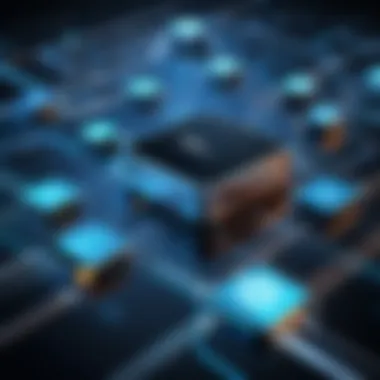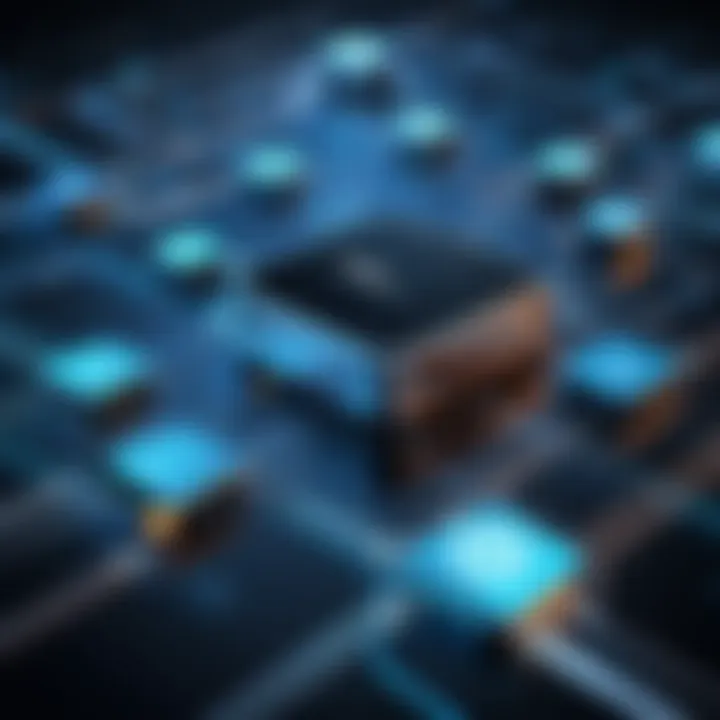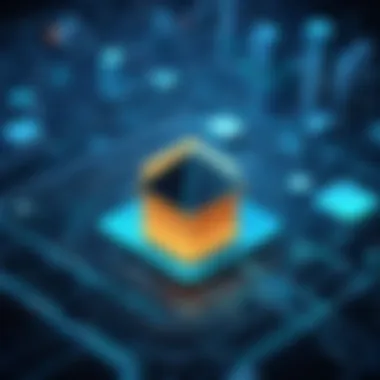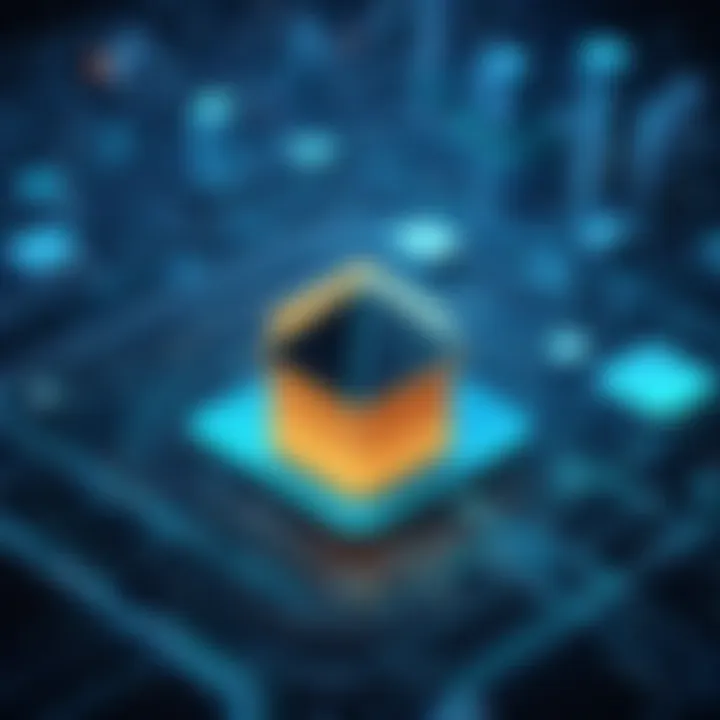Understanding the Internet of Things: Definition and Examples


Intro
The Internet of Things (IoT) is reshaping the way we interact with technology. This interconnected network enables devices to communicate, collect, and exchange data. Understanding IoT is critical for professionals, entrepreneurs, and tech enthusiasts alike.
As we delve into defining IoT, real-world examples will illuminate its applications. This article aims to map out the landscape of IoT, highlighting the technologies rampant in this domain and their implications in various sectors. Also, we must address some of the concerns that emerge with such extensive connectivity, including cybersecurity and ethical considerations.
Technological Research Overview
Recent Technological Innovations
IoT has seen substantial advancements—be it in hardware or software. For example, devices now range from smart home products like Nest thermostats to larger industrial systems that automate production lines. These innovations enhance efficiency and foster connectivity.
Key technologies include:
- Cloud Computing: Serves as the backbone for IoT data management.
- Artificial Intelligence: Empowers intelligent decision-making from accumulated data.
- Edge Computing: Reduces latency, allowing faster data processing closer to the source.
By leveraging these technologies, businesses can achieve streamlined operations.
Impact on Business Operations
IoT influences many areas of business, from supply chain management to customer service. With sensors and data analytics, companies can track inventory, monitor equipment performance, and personalize customer experiences.
Take retail, for instance. By implementing IoT systems, stores can automate inventory restocking and tailor promotions to individual shoppers through sensors that gather data on shopping behavior. This demonstrates how IoT makes operations more precise and aware of user needs
Future Technological Trends
The trajectory of IoT is promising, with 5G networks poised to enhance its capabilities further. Faster communication leads to real-time data sharing, thereby augmenting decision-making processes. As smart technologies advance, we can expect to see more applications in fields such as transportation, where autonomous vehicles will rely heavily on IoT frameworks. Enhanced interoperability between devices will further broaden IoT's horizons, sustainably improving various operations across industries.
By keeping tab on these trends, businesses can not only stay relevant but lead in their respective sectors.
Data Analytics in Business
Importance of Data Analytics
Data analytics plays a quintessential role in exploiting IoT's potential. As devices collect vast amounts of data, analyzing this information is imperative in making informed decisions. Businesses utilize analytics to gain insightful trends, forecasts, and customer behavior patterns.
Tools for Data Analysis
Numerous tools alow organizations to translate data into actionable strategies. Popular solutions include Google Analytics, Tableau, and Microsoft Power BI. Each tool offers a unique set of features to visually harmonize data from various IoT devices.
Case Studies on Data-Driven Decisions
Instances abound where companies have enhanced their performance through data-driven decision-making. For example, Walmart leverages IoT data analytics to adjust its product stock across thousands of stores based on real-time demand signals derived from sensors. Such implementations drive sales while minimizing waste.
Preamble to the Internet of Things
The Internet of Things, or IoT, represents a transformative shift in how technological ecosystems interconnect and operate. Understanding this phenomenon is vital for professionals and organizations aiming to navigate a landscape increasingly influenced by interconnected devices. Grasping the implications of IoT can uncover opportunities for better efficiency, adaptability, and innovation in various sectors.
Its evolution is marked by advancements in technology, particularly regarding how devices communicate and process data. Key benefits such as increased automation, improved decision-making, and enhanced user experiences all emerge from the confluence of devices deeply integrated into daily operations. It's also essential to consider its broader impacts on societal behaviors, urban landscapes, and business models.
Historical Context and Development
The concept of connected devices is not entirely new. Early machine-to-machine communication dates back to the 1960s, but the modern IoT as we understand it began to take shape in the late 1990s. Proposals and early implementations laid the groundwork, though specific defining elements remained elusive for years.
With the proliferation of the internet and mobile technologies, sudden breakthroughs came. The development of IPv6 expanded the potential addresses for connected devices, making the idea of a world filled with smart devices more feasible. As technology grew more sophisticated and affordable, manufacturers began to introduce household and industrial products observed today. This historical arc provides the context needed to grasp the magnitude and promise of IoT in our contemporary world.
Core Components of IoT
The architecture of Internet of Things is generally defined by three main components. Adequate understanding of these elements is essential in knowing how IoT functions and its broader implications.
Devices and Sensors
Devices and sensors form the foundation of IoT systems. These components collect data from their surroundings, transforming physical phenomena into digital signals. A key characteristic of devices and sensors is their ability to capture real-time data, making them a suitable choice for being integrated into IoT frameworks.
Each device often includes sensors tailored for specific functions: temperature, humidity, motion detection, and more. Their unique feature is high adaptability across various fields, increasing their widespread use in applications from agriculture monitoring to home automation. However, challenges such as power consumption and the complexity of maintenance can impede their performance.
Connectivity Protocols


Connectivity is fundamental to the operation of IoT. Various protocols govern how devices and sensors transmit information over networks. Key aspects of connectivity protocols include reliability and speed. These factors add significant value to IoT orchestration.
The standout quality of connectivity protocols is their versatility; they can seamlessly bridge devices across different communication standards. An illustrative example includes MQTT, which is oftentimes optimized for low-bandwidth applications. The increase in data interconnectivity enhances overall system intelligence, although network instability remains a pertinent concern.
Data Processing and Analysis
Data processing and analysis are crucial for turning collection of raw data into actionable insights. This component processes streamed information, ensuring relevant predictions and improvements are realized. A core feature is the use of machine learning models, which enhance the decision-making process as more data becomes available.
Utilizing local versus cloud-based processing dramatically shifts response times. Local processing increases speed and decreases data transmission frequency, an appealing trait for time-sensitive applications. Meanwhile, cloud options promote reduced costs through scalable resources. Nonetheless, concerns relating to latency and bandwidth will always influence decisions within IoT frameworks.
Defining the Internet of Things
Technical Definition
The Internet of Things, often abbreviated as IoT, refers to the network of interconnected devices that communicate with each other via the internet. This concept implies that everyday objects like street lights, washing machines, and even refrigerators can collect and exchange data. These devices are equipped with sensors, software, and other technologies allowing them to connect to the internet and interact with various systems.
One significant aspects of IoT includes its reliance on various connectivity protocols. For instance, devices may use protocols like MQTT, CoAP, or HTTPS for messaging. Therefore, the devices can send and receive data efficiently without significant delays. As IoT evolves, various standards emerge, making the environment stringently defined, leading to ripple effects in both ease of integration and operational effectiveness.
Importance in Today’s Digital Landscape
Understanding the Internet of Things holds considerable significance within the contemporary digital economy. As businesses and consumers accelerate their adoption of IoT technologies, this ecosystem brings both convenient and enhanced operational capabilities. The central premise of IoT is not just interconnectivity, but also optimizing efficiencies, reducing costs, and possibly creating new revenue streams.
For businesses, embracing IoT can lead to profound benefits—ranging from improved productivity to enhanced customer engagement. For instance:
- Real-time monitoring: Companies can monitor equipment status or consumer behavior and adjust strategies accordingly.
- Data-driven decisions: Insights gleaned from internet-connected devices provide actionable data, influencing everything from inventory management to marketing tactics.
- Operational agility: The flexibility offered through connected systems enables quick adaptation to changing market needs or supply chain dynamics.
Furthermore, IoT empowers sectors such as healthcare, agriculture, and smart city development, driving transformational changes across multiple domains of modern living, efficiently using resources, and enhancing overall quality of life.
The real power of IoT lies in its ability to drive change across entire sectors, reshaping traditional business models and individual consumer practices alike, impacting almost every industry from healthcare to transportation.
Grasping the depth and implications of the Internet of Things allows executives and decision-makers to prioritize investments strategically, align suitable technology solutions, and capitalize on the unprecedented opportunities this technology can unveil.
Examples of Internet of Things Applications
In discussions around the Internet of Things, real-world applications illustrate the technology's potential. By presenting various use cases, this section highlights the practical benefits of IoT across different sectors. This examination reveals how IoT can optimize operations and enhance user experiences. The goal is to illuminate the enhanced connectivity that enabled these developments. From smart homes to industrial applications, the influence of IoT is pervasive and continues to grow.
Smart Home Devices
Smart home devices exemplify how IoT integrates into daily life, enhancing comfort and control for users. The ability to manage household functions from a distance may lead to better energy efficiency and security. These devices become central in transforming conventional homes into smart homes, facilitating remote access and control over various systems.
Smart Thermostats
Smart thermostats are one specific smart home device. These thermostats adjust heating and cooling settings according to user preferences and habits. A key characteristic is their ability to learn over time. This learning ability results in energy savings by optimizing heating schedules and reducing unnecessary consumption.
A unique feature is remote access through smartphone applications. Users can monitor and manage their home temperature from anywhere. This not only enhances comfort but also offers savings on energy bills. Potential disadvantages include dependency on a stable internet connection for operation, which can lead to temperature management issues if disrupted.
Smart Security Systems
Smart security systems represent another important application of home automation. These systems allow for advanced surveillance, motion detection, and emergency notifications. A highlighted characteristic is real-time alerts sent directly to a phone. Users stay informed hether they are close to home or away.
Multi-faceted features, such as night vision and facial recognition, create a comprehensive security network. Despite advantages in safety and convenience, concerns may arise regarding privacy. Overreliance on technologies can lead to false alarms, requiring consideration in these setups.
Industrial IoT
Industrial IoT profoundly impacts manufacturing and logistics sectors. By connecting machinery with data analytics, companies achieve greater operational insights that lead to enhanced efficiency. Monitoring equipment performance in real-time can also minimize downtime through timely interventions.
Predictive Maintenance
Predictive maintenance is a vital aspect within Industrial IoT framework. This approach facilitates the identification of potential equipment failures before they materialize. A key advantage is the ability to schedule maintenance based on actual machine condition rather than a fixed schedule. Such precision reduces unplanned downtime.
Unique to this process is the use of sensors for ongoing data collection. These sensors track usage patterns, vibrations, and temperature fluctuations. There may also be disadvantages such as initial costs associated with implementing such systems and employee training. Nevertheless, the potential cost savings and productivity improvements frequently outweigh these concerns.
Supply Chain Optimization
Supply chain optimization maximizes efficiency in product delivery, inventory management, and logistics. Utilizing IoT, firms can gain visibility into their supply chains. A key advantage is real-time tracking, enabling timely responses to market demands and disruptions.
A unique factor of supply chain optimization includes data analytics that helps predict trends and streamline operations. However, complexities in supply chain systems can make integration difficult. Managing such systems requires trained personnel familiar with both industry processes and IoT technologies.
Healthcare Innovations


The healthcare sector exemplifies pivotal IoT innovations aimed at transforming patient care. From equipment monitoring to patient engagement, the IoT alters traditional paradigms in healthcare settings.
Remote Patient Monitoring
Remote patient monitoring is an excellent example of this trend. This technology enables healthcare providers to track a patient’s health metrics at distance. Key characteristics are improvement in chronic disease management through constant data access, and patients can focus on their health outside the clinical environment.
Though this approach promotes convenience and versatility in care, keeping patient data private remains critical. Network vulnerabilities might jeopardize patient information if no appropriate precautions are taken. Yet, overall, its many advantages continue to encourage adoption.
Smart Medical Devices
Smart medical devices incorporate IoT to enhance diagnostics and treatment capabilities. An important aspect includes real-time data transmission about patients' health state to doctors. This approach ensures timely and informed medical decisions.
Certain devices feature adaptive biometry, which allows real-time reajustments based on emerging data. For instance, glucose monitors can upload patient levels instantaneously. While very beneficial, there are challenges such as gastrointestinal issues linked to inaccurate readings that required precise tuning.
Smart Cities and Infrastructure
The concept of smart cities utilizes IoT technology to improve urban living conditions. By monitoring systems like traffic, waste management, and environmental resources, municipalities can streamline services effectively.
Traffic Management
Traffic management highlights the dynamic informarion flow IoT could enable in urban areas. Sensors linked to traffic signals adapt to changing road conditions, thus reducing congestion. A pivotal benefit is reduced wait times for commuters.
Unique to traffic management systems are analytical data dashboards that help city planners study patterns. Accurate data influences project engineering decisions and potentially upgrades city road networks. Some disadvantages echo concerns of privacy whereby extensive sensor networks present risks related to civilian surveillance because of data collection practices.
Public Safety Improvements
Public safety improvements represent a central aim of IoT in smart cities. The integration of cameras and environmental sensors can help develop prompt emergency response systems. A major feature is the capability to facilitate coordination during crises using interconnected systems.
One unique aspect includes real-time feeds to emergency dispatch, which directly enhance response times by almost instantly relaying events. Seguridad and efficiency ensue as investigators access pertinent information from different sensors. However, integrating technological systems systematically in diverse urban contexts might face budgetary and infrastructure barriers.
In summary, the applications of the Internet of Things span across various sectors, showcasing its effectiveness and versatility. Evaluating each area can facilitate better understanding of operational compatibility and possible hurdles therein. Continuous adaptations and enhancements strengthen reasons to consider implementing IoT solutions in proprietary decisions.
Potential Benefits of IoT in Business
The adoption of the Internet of Things (IoT) is transforming the landscape of modern business. Organizations increasingly recognize how connected devices can drive efficiency, enhance decision-making, and improve customer engagements. As businesses harness IoT technologies, it is vital to explore the potential benefits. By understanding these advantages, companies can continue to innovate and gain a competitive edge—an important aspect of a successful business strategy.
Operational Efficiency
One of the foremost benefits of IoT in business is operational efficiency. IoT devices enable real-time monitoring of machinery and processes. For example, sensors can track performance data, predicting equipment failures before they occur. This ability minimizes downtime, allowing businesses to optimize their workflow and reduce costly disruptions.
Additionally, automation is simpler with IoT integration. Routine tasks, when programmed, can function without human intervention. Companies like General Electric utilize IoT technologies to enhance their manufacturing processes significantly, cutting costs and increasing productivity in response.
Key aspects of operational efficiency through IoT:
- Predictive Maintenance: Continuous monitoring can help identify potential issues early, thereby planning equipment repairs without major disruptions.
- Resource Optimization: Elements like supply chain processes become streamlined. By tracking assets effectively, businesses can operate with less waste.
- Reduction in Energy Consumption: Smart devices manage energy usage, contributing to cost savings and environmental sustainability.
Enhanced Data Collection
IoT systems generate massive volumes of data. This information often offers valuable insights into market trends and consumer behavior. With the analytics capability merged with IoT technologies, businesses can leverage collected data for precise decision-making.
Various industries employ this enhanced data collection. For example, retailers use IoT for inventory management, replacing manual processes. Through RFID tags and sensors, firms understand stock levels in real-time. Similarly, in logistics, companies like FedEx utilize IoT for tracking shipments.
Advantages of enhanced data collection:
- Timely Insights: Promptly collected data helps businesses respond quickly to changing trends or issues.
- Customization of Services: Data-driven insights allow for personalization, enhancing the customer experience.
- Risk assessment: With continuous data flow, potential risks can be analyzed and mitigated efficiently.
Improved Customer Experience
The integration of IoT technologies leads to an improved overall customer experience. IoT allows businesses to interact with consumers more effectively by providing services tailored to their preferences.
Smart devices like smart speakers or cameras enhance customer interactions. Streaming services can suggest films based on viewer history through connected devices. Similarly, businesses in fields such as hospitality have started to implement smart room technology—offering an adaptable guest experience. Companies, such as Crown Plaza Hotels, utilize IoT solutions for room customization based on guest preferences.
Ways IoT can improve customer experience:
- Feeback Loops: Rapid communication through smart interfaces can be created for service improvements based on customer feedback.
- Loyalty Programs: IoT data assists companies in strategizing targeted marketing campaigns among loyal customers.
- Proactive Support: Automatic issue detection enhances customer lineage through timely assistance before customers recognize any issues themselves.
IoT not only transforms business operation but also reframes customer interactions by creating a more engaging and personalized experience.


Challenges and Risks of the Internet of Things
The Internet of Things is not just about convenience and efficiency. As IoT continues to transform many sectors, one must also consider the challenges and risks that come with integrating this technology into everyday processes. Understanding these vulnerabilities is crucial for successful adoption and implementation.
Security Vulnerabilities
One of the most significant challenges IoT faces is security. The increased number of connected devices means a wider attack surface for malicious actors. Devices that lack robust security measures can be easily compromised, leading to unauthorized access and data breaches. An attacker can potentially gain control of IoT devices like smart locks, thermostats, or even cameras.
Moreover, many IoT devices still operate on outdated protocols and firmware. Manufacturers often prioritize ease of use over security. This negligence can lead to unpatched vulnerabilities that can be exploited. By ensuring strong security measures and regular updates, businesses can mitigate these risks.
Research indicates that over 80% of companies have faced a cyberattack through their IoT devices.
“In the era of IoT, proper security is not an option; it is a necessity.”
Data Privacy Concerns
Alongside security vulnerabilities, data privacy is another pressing issue. When IoT devices collect data, they also generate potential privacy breaches. For instance, devices used in health monitoring can expose sensitive health data about users. This creates a dilemma for organizations regarding how to balance necessary data collection with safeguarding user privacy.
Furthermore, users often unwittingly grant broad permissions to IoT devices during installation. They may not read terms and conditions, leading to more extensive data collection than necessary. Organizations must establish transparent data policies Delineating what data is collected, why it's needed, and how it will be utilized helps build trust among users.
It is essential to adopt regulation that prioritizes user privacy. Some countries have initiated regulations, like GDPR in Europe, that address privacy concerns. Companies must comply with these laws, ensuring they are not only protective of user information but also transparent about its use.
Interoperability Issues
As IoT devices proliferate, interoperability becomes a critical challenge. Each device might operate on different platforms or protocols. This fragmentation creates complications for integrating them into a cohesive system. For instance, a smart home ecosystem with devices from multiple manufacturers can lead to compatibility issues where they cannot communicate effectively.
These interoperability issues can constrain the grip of IoT technologies, limiting their scope for companies. To address this, the industry must establish unified standards that guide manufacturers in developing products. Such frameworks can allow different devices to collaborate more seamlessly, leading to enhanced functionality.
Ethical Considerations in IoT Implementation
The expansion of the Internet of Things (IoT) presents numerous opportunities along with profound ethical challenges. It is essential for professionals to thoroughly understand these issues prior to integration in their frameworks. Datapoints, devices, and user interactions generate a plethora of data that necessitate ethical scrutiny.
User Consent and Data Ownership
User consent is a cornerstone within IoT ethics. Particularly where performance and user engagement are necessary, it becomes increasingly difficult to ensure that consent is genuinely informed. This brings forth a corresponding need for overall transparency about how data is utilized. Organizations must adopt clear policies to communicate data use purposes openly. Tech companies, like Google, face tension between improving services and user assurance over data protection. Clarity reinforces trust, which is beneficial in retaining users long-term.
Furthermore, data ownership is often ambiguous in IoT ecosystems. When devices collect user information, questions arise about who controls that data. Is it the user who generated it or the business facilitating the collection? Tension between device manufacturers and users is symptomatic of this. Strengthening user rights may also invite government scrutiny regarding regulation. Recommended practices involve establishing structural frameworks that allocate data ownership fairly, ensuring user data autonomy while complying with local laws.
“Effective data governance this strengthens the relationship between the user and providers.”
Implications for Employment
As IoT continues to embed itself across industries, employment dynamics may witness perceptible shifts. On one side, jobs may become more automated due to the embedding of smart technologies into routine operations, which can pivot toward enhancing efficiency. For example, machinery in factories may optimize tasks, diminishing manual roles remarkably. Such reality suggests potential job displacement for a segment of the workforce that lacks proper reskilling.
On the other hand, new sectors and job forms might emerge due to IoT inducing innovation. Professionals like data analysts, cybersecurity experts, and systems evaluators will be in demand as companies scale operations. Associated schooling systems must improve alignment with new realities creating relevant curriculums. Addressing these concerns can catalyze transitions for individuals moving into suitable roles.
In sum, navigating the approach towards IoT's ethical considerations, particularly around user consent and employment implications, requires strategic foresight and a proactive response. Sustainability and compliance depend strongly on each organization’s frameworks, particularly confronting user-building trust while embracing personnel growth opportunities.
The Future of the Internet of Things
The future of the Internet of Things (IoT) is pivotal in shaping our interconnected environment. It is not just about the technology itself, but the implications it has for society, business, and everyday life. As IoT expands, it will redefine how we interact with the digital and physical worlds, creating both opportunities and challenges that require careful consideration.
Trends to Watch
- Environmental Sustainability: One major area of focus will be the role of IoT in promoting sustainability. With smart sensors and devices, businesses can optimize resource usage, minimizing waste and reducing carbon footprints. This is crucial as climate change talks dominate the global agenda.
- Increase in Edge Computing: As the volume and speed of data generated by IoT devices increases, there is a shifting tendency towards edge computing. This method processes data near its source rather than sending it to a centralized cloud. This can significantly lower latency and improve real-time analytics capabilities, benefiting industries ranging from healthcare to automotive.
- Integration of Artificial Intelligence: The fusion of IoT with artificial intelligence will lead to more adaptive systems. These systems will not merely reroute processes but will also be able to predict issues before they arise. Using advanced algorithms, IoT devices can learn user preferences and personal habits, creating a more tailored experience.
- Emergence of 5G Technology: The rollout of 5G connectivity will accelerate the proliferation of IoT devices. Thanks to its high data transfer rates and low latency, 5G is crucial for applications requiring instant communication. This will enhance smart cities, where everything from transportation systems to utilities gets optimized.
- Enhanced Security Measures: As the dependence on IoT grows, concerns over security will increase as well. Future trends will place a premium on robust security frameworks built specifically for IoT systems. Enterprises will need to ensure that their data and operations remain safeguarded from vulnerabilities.
"Understanding the future of IoT involves acknowledging both its innovative potential and the risks it harbors. Balancing these factors will be essential for stakeholders."
Potential for Innovation
The potential for innovation within the IoT space is immense. Industries can leverage new IoT technologies to create more efficient systems and delivery processes. For example, in agriculture, IoT can optimize irrigation and conservation practices through real-time monitoring of soil conditions. This transforms traditional methodologies, illustrating how connected technology can ease labor and yield better results.
Moreover, there's growth in interoperability standards, allowing different IoT devices and systems to connect seamlessly. This interoperability enhances flexibility, providing developers with tools to create various solutions across multiple platforms.
Healthcare is another sector with vast innovation opportunities through IoT applications. Remote biomonitoring devices enable real-time health tracking, reducing unnecessary hospital visits. This can also drastically improve health outcomes by allowing for timely interventions based on live data.
In sum, the future of IoT is bright, marked by a blend of sustainability and innovation. As various industries prepare for these upcoming trends, understanding both the risks and opportunities they bring is crucial. Organizations will need to adapt quickly to thrive in this evolving landscape.
End
The conclusion of this article synthesizes the importance of the Internet of Things. In this age of rapid technological change, understanding IoT is crucial. The implications of IoT extend beyond mere convenience; they reshape how businesses operate and interact with consumers. This technology fosters greater efficiency, automation, and data-driven decision-making. As IoT devices increase in ubiquity, failing to grasp its operational frameworks can hinder strategic planning.
Recap of Key Insights
Throughout this article, several key points about IoT have emerged. The historical context highlights how IoT evolved from simple connected devices to the complex networks we see today. Innovations in devices and sensor technologies pave the way for various applications in homes, industries, healthcare, and infrastructure.
Summary of core insights:
- Evolution of IoT: From inception to present.
- Importance in business: Enhancing operational efficiency and customer experience.
- Challenges: Security, data privacy, and interoperability present ongoing concerns.
- Future trends: Advancements will likely change the landscape of connectivity and innovation.







